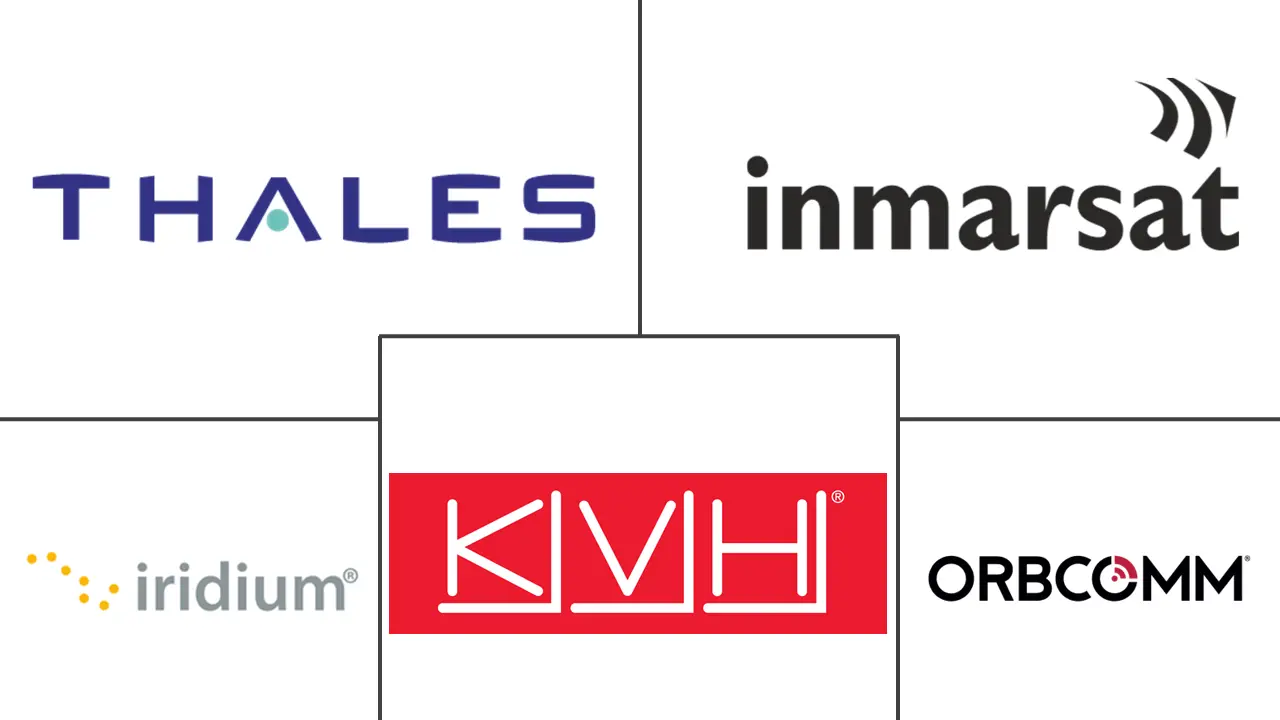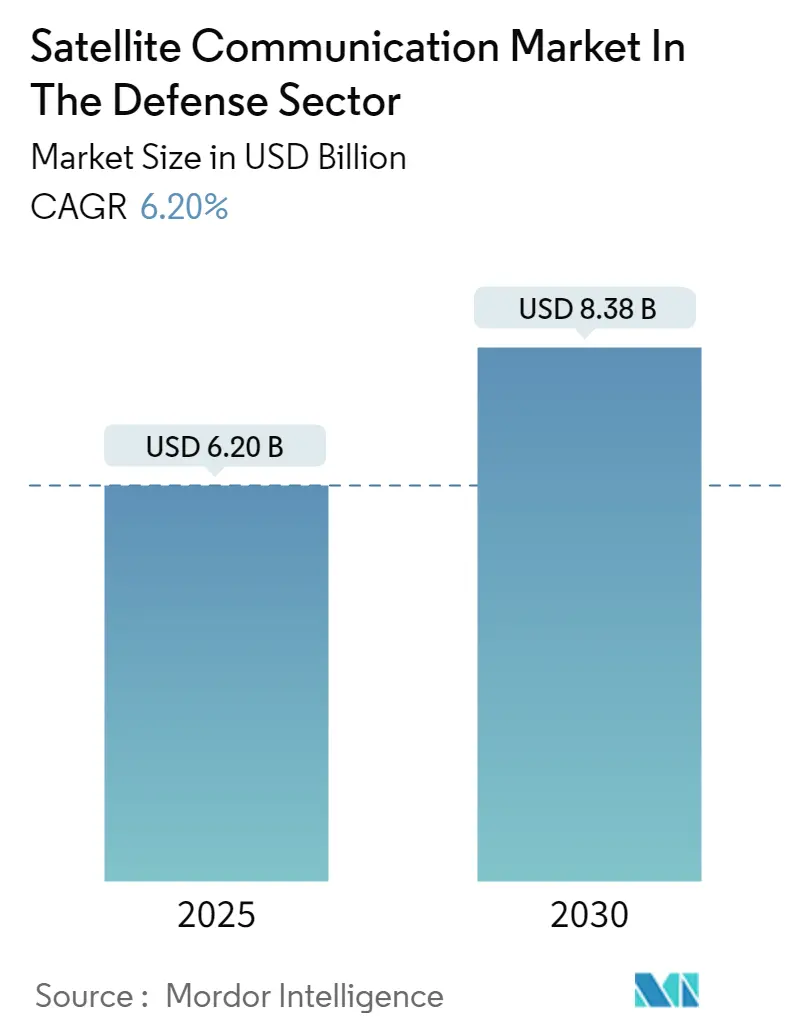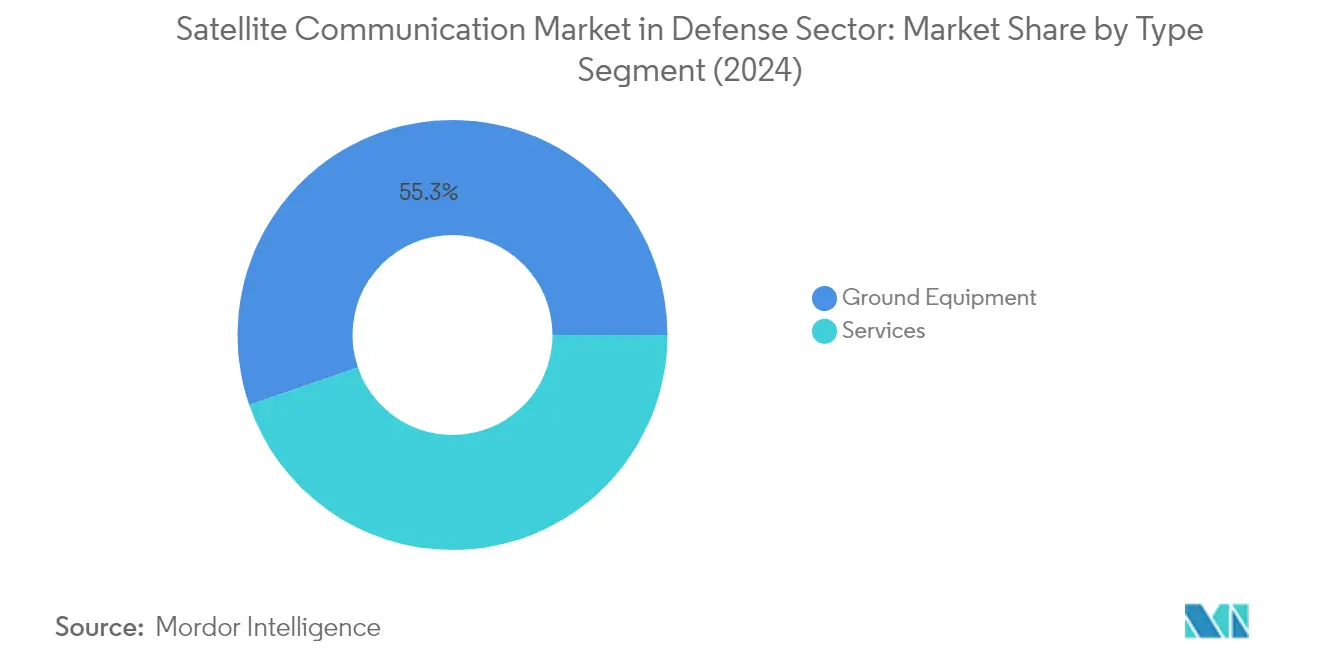Satellite Communication Market Analysis
The Satellite Communication Market In The Defense is expected to grow from USD 6.20 billion in 2025 to USD 8.38 billion by 2030, at a CAGR of 6.2% during the forecast period (2025-2030).
The satellite communication landscape is experiencing unprecedented transformation driven by technological advancement and increasing space commercialization. According to the Union of Concerned Scientists, as of January 2022, there were 4,852 active artificial satellites orbiting Earth, with the United States operating 2,944 of these satellites, highlighting the growing orbital infrastructure supporting global defense communications. The emergence of smaller, smarter satellites with compact components is revolutionizing the industry, as commercial operators increasingly deploy smallsat constellations in Low Earth Orbit (LEO) to provide global coverage with reduced latency. This shift towards compact satellites is further supported by innovations in mass production techniques, shared launch opportunities, and standardized satellite buses.
The integration of military satellite communication with terrestrial networks is reshaping the industry's technological framework. Companies are advancing this evolution through the development of high-throughput satellites using Ku-band technology, specifically designed for aerospace, defense, and maritime applications. The deployment of high-throughput satellite (HTS) systems by established players has been instrumental in driving satellite capacity supply, which is anticipated to increase significantly over maritime regions in the coming years. This technological convergence is particularly evident in the implementation of 5G networks via satellites, representing a crucial advancement in global communication infrastructure.
Maritime satellite communications have become increasingly vital to global trade and security operations. According to the EMEA Satellite Operations Association, secure satellite communications have become the standard for 98% of merchant vessels, underscoring their critical role in maritime operations. The OECD forecasts that sea trade volume will reach 180 billion metric tons by 2030, highlighting the growing importance of reliable satellite communication systems in supporting global maritime commerce and security operations. This expansion is driving innovations in maritime-specific satellite solutions, including enhanced bandwidth capabilities and improved coverage in remote oceanic regions.
The industry is witnessing significant investments in space-based infrastructure and capabilities. In February 2024, the United Kingdom announced a £1.4 billion investment in its first Defense Space Strategy, including the development of a global surveillance satellite system. This investment exemplifies the growing recognition of military communications' strategic importance in national defense. Similarly, commercial ventures are expanding rapidly, as evidenced by Amazon's Project Kuiper agreement to conduct approximately 83 launches over a five-year period, demonstrating the private sector's commitment to expanding satellite communication capabilities. These developments are complemented by advancements in laser communication technology, which promises to provide data transmission from space to Earth at speeds equivalent to superfast broadband.
The role of military satcom is increasingly pivotal in enhancing defense capabilities, providing secure and reliable communication channels essential for modern military operations. The integration of milsatcom systems with terrestrial networks is crucial for achieving seamless communication across various defense platforms.
Satellite Communication Market Trends
Increased Seaborne Threats and Ambiguous Maritime Security Policies
Maritime terrorism, drug trafficking, gunrunning, piracy, and other non-traditional seaborne attacks have emerged as significant threats to national security, driving the need for advanced military telecommunications systems in defense operations. The Indo-Pacific region has garnered particular attention due to various connectivity initiatives from major powers, including the United States, China, Russia, Japan, Australia, India, and ASEAN countries, necessitating robust maritime security infrastructure. The security situation is especially critical in regions like the Horn of Africa, where violent insurgencies along sea routes pose substantial threats to adjacent countries' political and economic stability, compelling defense organizations to enhance their satellite communication capabilities for maritime surveillance and monitoring.
The absence of a comprehensive multi-nation maritime security strategy across oceans has led to increased vulnerability in naval force projection, driving investments in satellite-based security systems. There have been documented cases of linkages between cyberattacks and physical piracy, where pirates allegedly accessed shipping corporations' systems to identify vessels carrying valuable cargo with minimal onboard protection. This evolution in maritime threats has resulted in a shift from conventional force-structured defense forces toward asymmetric forces, emphasizing the critical role of military satellite technology in maintaining maritime security, protecting the marine environment, supporting the blue economy, and ensuring the human security of coastal populations.
Rise in Demand for Military and Defense Satellite Communication Solutions
The defense sector's increasing reliance on secure and reliable data communications has catalyzed significant investments in satellite communication technologies. The Japanese government's approval of JPY 5.4 trillion (USD 47.2 billion) in defense spending in 2022 and South Korea's allocation of KRW 266.4 billion (USD 220 million) for developing stealth drones and military assets exemplify the growing emphasis on advanced satellite communication capabilities. The military and defense industry prioritizes the privacy and security of communications, particularly given the rising volume of IP-based data, including situational awareness video and remote sensor data, transmitted across standard interfaces. The need to protect military satellites from cyberattacks has become increasingly critical as cyber resources on the ground, air, and space face diverse threats.
The application of artificial intelligence in satellite communication for earth-based surveillance has emerged as a primary driver of market growth in the defense sector. Remote sensing capabilities have evolved significantly, offering military organizations high-resolution imagery across various light wavelengths, enabling effective tracking of enemy force movements and tactical threat assessment. The United States Military, recognizing the limitations of military-owned satellite technologies in meeting the growing demand for connectivity and high-resolution imaging, has increasingly relied on commercial satellite capabilities. This trend is further supported by the development of specialized satellites with diverse capabilities, including optical satellites, radar imaging satellites, ultraviolet and infrared imagery satellites, and signal intercepting communication satellites, enhancing the overall military communications infrastructure.
The integration of tactical data link systems within these satellite communications has become crucial for real-time data exchange and operational efficiency. As defense communications evolve, the role of tactical data link in ensuring seamless and secure data transfer between various military units becomes increasingly significant, further driving the demand for advanced defense communications solutions.
Segment Analysis: Type
Ground Equipment Segment in Satellite Communication Market for Defense Sector
The Ground Equipment segment continues to dominate the satellite communication market in the defense sector, holding approximately 55% market share in 2024. This segment encompasses critical components like Satellite Gateways, Very Small Aperture Terminal (VSAT) Equipment, Network Operation Centers (NOC), and Satellite News Gathering (SNG) Equipment. The segment's prominence is driven by increasing investments in ground infrastructure modernization by defense organizations worldwide. The growing demand for secure and reliable communication networks, particularly in remote military operations, has led to enhanced adoption of advanced ground equipment. Military organizations are increasingly focusing on upgrading their ground stations with modern VSAT systems and network operation centers to support mission-critical communications. The integration of artificial intelligence and automation in ground equipment has further strengthened this segment's position, enabling more efficient and secure satellite communications for defense applications, including military satellite communications.
Services Segment in Satellite Communication Market for Defense Sector
The Services segment is projected to experience the highest growth rate of approximately 7% during the forecast period 2024-2029. This growth is primarily driven by the increasing demand for managed satellite services, mobile satellite services (MSS), and fixed-satellite services (FSS) in military operations. The segment's expansion is fueled by the rising need for secure and reliable communication channels in defense operations, particularly in remote and hostile environments. Defense organizations are increasingly outsourcing their satellite communication needs to specialized service providers who can offer end-to-end solutions, including network management, security services, and technical support. The adoption of new satellite technologies, including high-throughput satellites (HTS) and low Earth orbit (LEO) constellations, is creating new opportunities for service providers to offer enhanced communication capabilities to military customers. The growing emphasis on network-centric warfare and the need for real-time situational awareness are further driving the demand for advanced satellite communication services, leveraging military satellite technology.
Segment Analysis: Application
Surveillance and Tracking Segment in Satellite Communication Market in Defense Sector
The Surveillance and Tracking segment continues to dominate the satellite communication market in the defense sector, commanding approximately 42% market share in 2024. This segment's prominence is driven by the increasing deployment of space-based ballistic missile detection and tracking systems. The Space Tracking and Surveillance System (STSS) serves as a crucial experimental component of the United States Ballistic Missile Defense System (BMDS), enabling comprehensive missile tracking through all three phases of flight - boost, midcourse, and terminal. Modern battlefield surveillance missions heavily rely on these systems to detect, locate, identify, and monitor changes in enemy resources, including tanks, vehicles, helicopters, and air defense batteries. The integration of MTI mode and high-resolution SAR mode in ground surveillance radar systems aboard planes has significantly enhanced the segment's capabilities, allowing simultaneous display of moving targets' maps and radar images of the ground. The use of tactical data link systems further enhances the efficiency of these operations.
Remote Sensing Segment in Satellite Communication Market in Defense Sector
The Remote Sensing segment is projected to exhibit the highest growth rate of approximately 9% during the forecast period 2024-2029. This accelerated growth is attributed to the increasing adoption of nanosatellites and their expanding applications in defense operations. The advancement in optics and communication technologies has significantly improved the remote sensing and imaging capabilities of smaller spacecraft. The segment's growth is further fueled by the rising demand for earth observation satellites that provide critical data for military operations. Remote sensing satellites equipped with various sensors can detect different parts of the electromagnetic spectrum in visible, infrared, and microwave ranges, enabling comprehensive surveillance and intelligence gathering capabilities. The integration of AI in satellite communication for earth-based surveillance and the growing emphasis on real-time monitoring applications are expected to drive substantial growth in this segment, supported by airborne satellite communications technologies.
Remaining Segments in Satellite Communication Market Applications
The Disaster Recovery and Other Applications segments collectively represent significant portions of the market, each serving distinct defense communication needs. The Disaster Recovery segment plays a vital role in enabling rapid response during emergencies and natural disasters, providing critical communication infrastructure when terrestrial networks are compromised. This segment focuses on maintaining operational and situational awareness during crisis situations, supporting everything from emergency response coordination to telemedicine services in affected areas. The Other Applications segment encompasses various specialized military communications applications, including tactical military communications satellite operations, ground-based communication terminals, and integrated satellite-based command and control systems. These segments continue to evolve with technological advancements, contributing to the overall robustness of defense satellite communication capabilities, including the use of airborne satellite communications and tactical data link systems.
Satellite Communication Market in the Defense Sector Geography Segment Analysis
Satellite Communication Market in Defense Sector in North America
North America continues to dominate the global military communications market in the defense sector, commanding approximately 42% of the global market share in 2024. The region's leadership position is primarily driven by its advanced technological infrastructure and robust network connectivity capabilities. The United States Space Force's operation of the sophisticated Satellite Control Network, which manages over 190 military and government satellites, demonstrates the region's technological superiority. The region's extensive coastal areas require continuous monitoring, creating sustained demand for naval SATCOM systems. The increasing commercial activities and trade volumes have intensified the need for maritime safety and surveillance capabilities. The region's focus on developing secure and reliable communication networks for military operations, coupled with substantial defense budgets and investments in space technology, continues to drive market growth. Furthermore, the integration of commercial satellite capabilities with military applications has enhanced the operational efficiency of defense communications, making North America a benchmark for global satellite communication infrastructure.
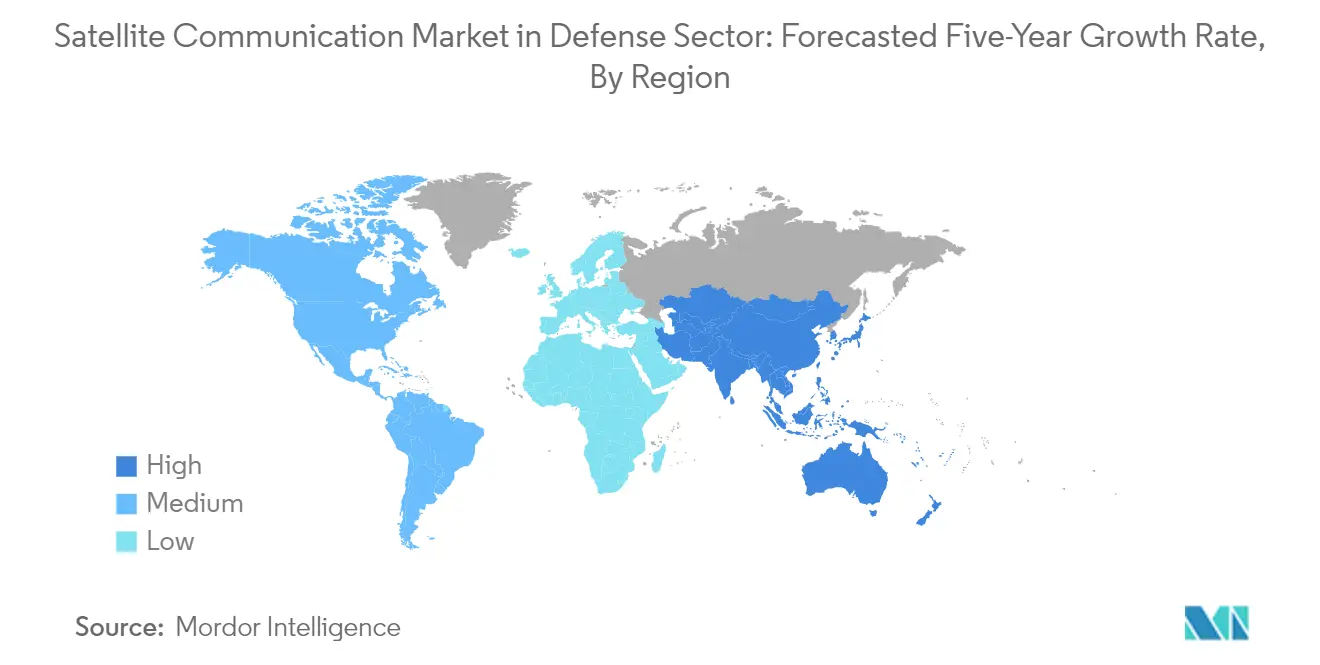
Satellite Communication Market in Defense Sector in Europe
The European satellite communication market in the defense sector has demonstrated robust growth, with an approximate growth rate of 7% from 2019 to 2024. The region's market dynamics are significantly influenced by increasing government and military dependence on military SATCOM systems. The European Union's commitment to space sector development, particularly in satellite communications, has been instrumental in shaping the market landscape. The implementation of GOVSATCOM as part of the EU Space Programme has created a framework for secure and cost-effective communications capabilities for security and safety-critical missions. European nations are actively investing in developing sophisticated satellite networks to enhance their defense and security infrastructure. The integration of satellite communications with existing defense systems has become a priority for European military organizations, leading to increased adoption of advanced SATCOM solutions. The region's focus on developing autonomous satellite communication capabilities, combined with efforts to reduce dependence on foreign satellite systems, has created a robust ecosystem for market growth.
Satellite Communication Market in Defense Sector in Asia-Pacific
The Asia-Pacific satellite communication market in the defense sector is projected to experience substantial growth with an estimated CAGR of 8% during 2024-2029. The region is witnessing significant technological advancements and investments in research and development to strengthen satellite communication capabilities within defense organizations. Countries across the region are actively modernizing their military communication infrastructure to address emerging security challenges. The increasing focus on indigenous satellite development programs and the establishment of dedicated military communication satellites demonstrate the region's commitment to enhancing defense capabilities. The growing emphasis on maritime security and surveillance has created additional demand for secure satellite communications systems. The region's diverse geographical landscape, including vast oceanic areas, has necessitated robust satellite communication networks for effective military operations. Furthermore, the increasing adoption of advanced technologies like artificial intelligence and machine learning in satellite communications is reshaping the defense communication landscape in Asia-Pacific.
Satellite Communication Market in Defense Sector in Latin America
The Latin American satellite communication market in the defense sector continues to evolve with significant potential for growth. The region's focus on developing indigenous space capabilities and satellite communication infrastructure has created new opportunities for market expansion. Latin American countries are increasingly recognizing the strategic importance of satellite communications in military operations and national security. The establishment of regional space cooperation initiatives has fostered technological advancement and knowledge sharing among nations. The region's geographical characteristics, including vast remote areas and extensive coastlines, necessitate reliable satellite communication systems for defense operations. Military organizations across Latin America are modernizing their communication infrastructure to enhance operational efficiency and response capabilities. The growing emphasis on border security and surveillance has further accelerated the adoption of satellite communication solutions in the defense sector.
Satellite Communication Market in Defense Sector in Middle East & Africa
The Middle East & Africa region presents unique opportunities in the satellite communication market for the defense sector. The region's increasing focus on enhancing military capabilities and modernizing defense communication infrastructure has created a favorable environment for market growth. Countries in the region are actively investing in satellite technology to address growing security challenges and improve military operational efficiency. The demand for secure and reliable communication systems in remote areas has driven the adoption of satellite-based solutions. Defense organizations are leveraging satellite communications to enhance their surveillance and monitoring capabilities across vast territories. The region's strategic importance in global security affairs has necessitated advanced communication systems for military operations. Furthermore, the increasing focus on developing indigenous satellite capabilities and reducing dependence on foreign technology has created new opportunities for market development in the Middle East & Africa region.
Satellite Communication Industry Overview
Top Companies in Satellite Communication Defense Market
The satellite communication defense market features prominent players like Thales Group, Inmarsat, Iridium Communications, KVH Industries, Orbcomm, Cobham SATCOM, Thuraya, Viasat, ST Engineering iDirect, and L3Harris Technologies. These companies demonstrate a strong focus on product innovation through the development of advanced satellite terminals, modems, antennas, and communication systems specifically designed for military communications. Operational agility is evident through flexible terminal architectures, multi-band capabilities, and software-defined solutions that enable rapid deployment and mission adaptability. Strategic moves include significant investments in R&D for next-generation technologies like high-throughput satellites, low Earth orbit constellations, and integrated ground station networks. Geographic expansion is pursued through partnerships with regional players, the establishment of local offices, and collaboration with defense agencies across different countries to strengthen market presence and service delivery capabilities.
High Barriers Shape Competitive Dynamics
The market structure is characterized by the dominance of large global defense and aerospace conglomerates that possess extensive technological capabilities, established relationships with military customers, and significant financial resources for continued innovation. These incumbents have built strong competitive positions through decades of experience in developing secure satellite communications solutions for defense applications. The high barriers to entry, including substantial capital requirements, stringent regulatory compliance needs, and complex technical specifications, have resulted in a relatively consolidated market with limited new entrants.
Recent years have witnessed increased merger and acquisition activity as companies seek to expand their technological capabilities and market reach. Notable transactions include Viasat's acquisition of Inmarsat and GI Partners' acquisition of Orbcomm, demonstrating the trend toward consolidation to achieve scale economies and enhance service offerings. Strategic partnerships between satellite operators, equipment manufacturers, and defense contractors have also become common as companies look to combine complementary capabilities and address evolving defense communications requirements.
Innovation and Integration Drive Future Success
For established players to maintain and grow market share, continuous investment in technological innovation focused on enhanced security, reliability, and performance will be crucial. This includes developing solutions that enable seamless integration across different communication platforms, improving bandwidth efficiency, and ensuring resilience against emerging threats. Building stronger relationships with defense agencies through long-term service agreements and customized solutions will help secure recurring revenue streams. Additionally, expanding service portfolios to address emerging requirements like autonomous systems communication and space-based networks will be important for sustained growth.
New entrants and smaller players can gain ground by focusing on specialized capabilities or niche applications where they can demonstrate superior technology or cost advantages. This could include developing innovative solutions for specific military use cases or leveraging new technologies like small satellites and software-defined systems. However, success will require navigating complex regulatory requirements, building credibility with defense customers, and establishing reliable supply chains. The concentrated nature of defense customers and their preference for proven suppliers creates challenges, but opportunities exist through partnerships with established players or by addressing underserved market segments.
Satellite Communication Market Leaders
-
Thales Group
-
Inmarsat Communications
-
Iridium Communications Inc.
-
KVH Industries Inc.
-
Orbcomm Inc.
- *Disclaimer: Major Players sorted in no particular order
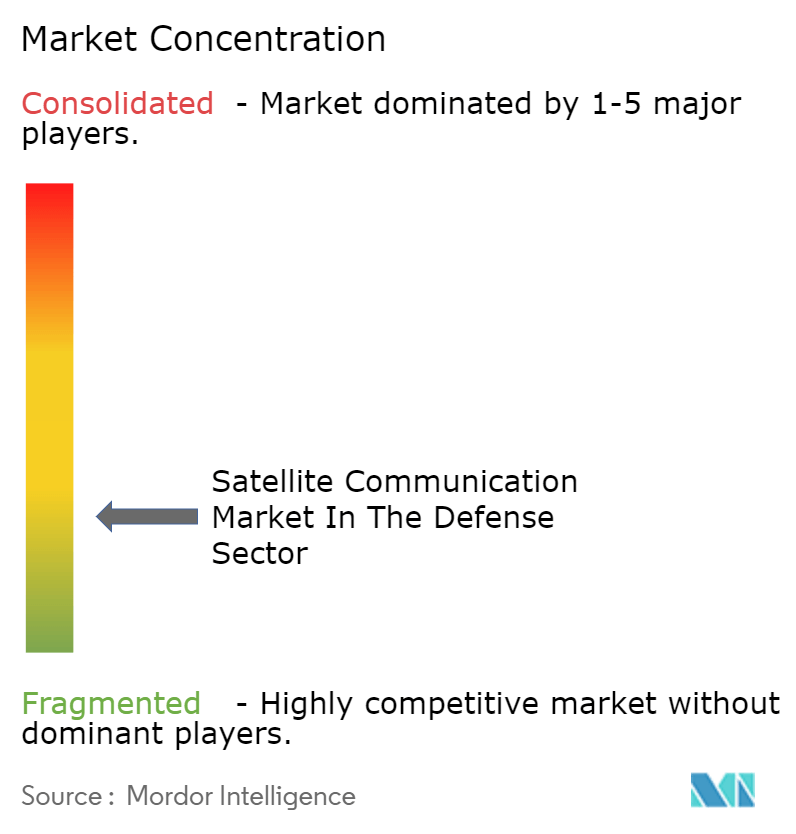
Satellite Communication Market News
- February 2024: SpaceX successfully launched six missile-detection satellites into orbit for a classified US military mission. The payload included two satellites for the Missile Defense Agency and four for the Space Development Agency. Notably, two of these satellites, one developed by L3Harris and the other by Northrop Grumman, are the first prototypes from the Missile Defense Agency’s Hypersonic and Ballistic Tracking Space Sensor (HBTSS) program. The remaining four satellites, all from L3Harris, are part of the Space Development Agency’s Tracking Layer Tranche 0. These demonstration satellites will provide critical test data as the SDA continues to build a comprehensive constellation for global missile threat indications, warnings, tracking, and targeting.
- January 2024: Iran achieved a significant milestone by launching three satellites for the first time. These satellites were deployed using a carrier rocket developed by Iran's Ministry of Defence and Armed Forces Logistics. This will enhance Tehran's ballistic missile capabilities. Iran has stated that the primary purposes of these satellites are to evaluate communication and geopositioning technologies and to assess the feasibility of space cargo delivery.
- February 2024: Viasat Inc., one of the global leaders in satellite communications, announced that AST (Applied Satellite Technology), one of the global leaders in satellite communication solutions, joined its ELEVATE program. ELEVATE is a growth program, ecosystem, and marketplace for ambitious IoT solution providers, connectivity wholesalers, enablers, and OEMs who want to work with Viasat to use its network and footprint to scale. As an ELEVATE partner, AST would offer globally trusted connectivity solutions that provide real customer value by enabling complete remote control to connect people, systems, and assets, even in the remotest locations.
Satellite Communication Market Report - Table of Contents
1. INTRODUCTION
- 1.1 Study Assumptions and Market Definition
- 1.2 Scope of the Study
2. RESEARCH METHODOLOGY
3. EXECUTIVE SUMMARY
4. MARKET INSIGHTS
- 4.1 Market Overview
-
4.2 Industry Attractiveness - Porter's Five Forces Analysis
- 4.2.1 Threat of New Entrants
- 4.2.2 Bargaining Power of Buyers
- 4.2.3 Bargaining Power of Suppliers
- 4.2.4 Threat of Substitute Products
- 4.2.5 Intensity of Competitive Rivalry
- 4.3 Industry Value Chain Analysis
- 4.4 Assessment of the Impact of Macroeconomic Factors on the Market
5. MARKET DYNAMICS
-
5.1 Market Drivers
- 5.1.1 Increased Seaborne Threats and Ambiguous Maritime Security Policies
- 5.1.2 Rise in Demand for Military and Defense Satellite Communication Solutions
-
5.2 Market Restraints
- 5.2.1 Cybersecurity Threats to Satellite Communication
- 5.2.2 Reliance on High-cost Satellite Equipment
6. MARKET SEGMENTATION
-
6.1 By Type
- 6.1.1 Ground Equipment
- 6.1.2 Services
-
6.2 By Application
- 6.2.1 Surveillance and Tracking
- 6.2.2 Remote Sensing
- 6.2.3 Disaster Recovery
- 6.2.4 Other Applications
-
6.3 By Geography***
- 6.3.1 North America
- 6.3.2 Europe
- 6.3.3 Asia
- 6.3.4 Australia and New Zealand
- 6.3.5 Latin America
- 6.3.6 Middle East and Africa
7. COMPETITIVE LANDSCAPE
-
7.1 Company Profiles*
- 7.1.1 Thales Group
- 7.1.2 Inmarsat Communications
- 7.1.3 Iridium Communications Inc.
- 7.1.4 KVH Industries Inc.
- 7.1.5 Orbcomm Inc.
- 7.1.6 Cobham PLC
- 7.1.7 Thuraya Telecommunications Company (Al Yah Satellite Communications Company P.J.S.C)
- 7.1.8 ViaSat Inc.
- 7.1.9 ST Engineering iDirect
- 7.1.10 L3Harris Technologies Inc.
8. INVESTMENT ANALYSIS
9. FUTURE OF THE MARKET
Satellite Communication Industry Segmentation
Satellite communication is the transmission of signals via a satellite in the form of a beam of modulated waves between the transmitter and reception antenna. These signals are amplified and delivered back to the Earth's surface reception antenna. Artificial satellites send and receive analog and digital signals containing data such as sounds, photos, and videos to and from one or more sites throughout the world. The global satellite communication market in the defense sector is diverse, complex, and heavily influenced by technological changes, regulations, and investment decisions by governments and the private sectors.
The satellite communication market in the defense sector is segmented by type (ground equipment and services), application (surveillance and tracking, remote sensing, disaster recovery, and other applications), and geography (North America, Europe, Asia-Pacific, Latin America, and Middle East & Africa). The report offers the market sizes and forecasts in terms of value (USD) for all the above segments.
| By Type | Ground Equipment |
| Services | |
| By Application | Surveillance and Tracking |
| Remote Sensing | |
| Disaster Recovery | |
| Other Applications | |
| By Geography*** | North America |
| Europe | |
| Asia | |
| Australia and New Zealand | |
| Latin America | |
| Middle East and Africa |
Satellite Communication Market Research FAQs
How big is the Satellite Communication Market In The Defense?
The Satellite Communication Market In The Defense size is expected to reach USD 6.20 billion in 2025 and grow at a CAGR of 6.20% to reach USD 8.38 billion by 2030.
What is the current Satellite Communication Market In The Defense size?
In 2025, the Satellite Communication Market In The Defense size is expected to reach USD 6.20 billion.
Who are the key players in Satellite Communication Market In The Defense?
Thales Group, Inmarsat Communications, Iridium Communications Inc., KVH Industries Inc. and Orbcomm Inc. are the major companies operating in the Satellite Communication Market In The Defense.
Which is the fastest growing region in Satellite Communication Market In The Defense?
Asia Pacific is estimated to grow at the highest CAGR over the forecast period (2025-2030).
Which region has the biggest share in Satellite Communication Market In The Defense?
In 2025, the North America accounts for the largest market share in Satellite Communication Market In The Defense.
What years does this Satellite Communication Market In The Defense cover, and what was the market size in 2024?
In 2024, the Satellite Communication Market In The Defense size was estimated at USD 5.82 billion. The report covers the Satellite Communication Market In The Defense historical market size for years: 2022, 2023 and 2024. The report also forecasts the Satellite Communication Market In The Defense size for years: 2025, 2026, 2027, 2028, 2029 and 2030.
Our Best Selling Reports
Satellite Communication Market In The Defense Sector Research
Mordor Intelligence provides a comprehensive analysis of the military SATCOM and defense communications landscape. We leverage decades of expertise in military telecommunications research. Our extensive report covers the evolving dynamics of military communications systems. This includes tactical data link technologies and secure satellite communications. The analysis encompasses developments in military satellite technology across airborne SATCOM, naval SATCOM, and ground-based systems. Detailed insights are available in an easy-to-download report PDF format.
Our strategic research benefits stakeholders across the MILSATCOM ecosystem by delivering actionable intelligence on military satellite communication trends and innovations. The report examines the evolution of the tactical data link market. It offers valuable perspectives on the growth drivers and challenges within the military communications market. From developments in the airborne SATCOM market to emerging standards in the tactical data link industry, our analysis empowers decision-makers. These insights are crucial for strategic planning and implementation in the defense sector.

